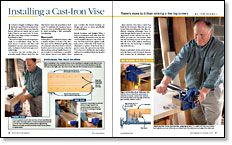Installing a Cast-Iron Vise
There's more to it than sinking a few lag screws
Synopsis: A cast-iron vise is a staple in any workshop, but if your shop lacks a good bench-mounted vise one can be installed without much fuss. In this article Fine Woodworking editor Tom Begnal offers tips and planning advice for installing a cast-iron vise in a variety of shop configurations. He explains the best places to locate the vise on your bench and demonstrates how to add a wood face to the cast-iron jaws to protect the workpieces.
It’s hard to imagine working in a shop that lacks a good bench-mounted vise. After all, woodworkers come from the factory with just two hands, and we need both of them to use most tools. So it usually takes some help to keep a workpiece fixed firmly in place.
The cast-iron style of vise has long been a staple in woodworkers’ shops, and for good reason. A cast-iron vise that’s well maintained can last several generations, and a workpiece locked in its grip won’t easily budge.
A cast-iron vise has another plus: It generally installs without much fuss. But that doesn’t mean the procedure is foolproof. To minimize the fussiness factor, there are a few worthwhile points to keep in mind—including a little preinstallation planning.
Where to put it
At first glance, a workbench seems to offer a number of places to locate a vise. But a few spots can be eliminated quickly. Any vise centered on the front, back or end of a bench is sure to be in your way, so the vise almost always ends up installed near a corner to make it as unobtrusive as possible. Your options narrow even further when you consider the bench location, its design and you—or more specifically, your handedness.
Bench location and design— When a bench is positioned well away from the walls, allowing all-around access, the vise can be installed adjacent to any of the corners. But if the bench butts against a wall, both corners of that side of the bench are eliminated as options. If the bench has to go in a corner, the options become fewer. So it’s best not to finalize the vise location until you’ve considered where the bench is going to go.
Most cast-iron vises have a metal dog built into the front jaw. When the vise dog is used with a benchdog, the vise offers additional clamping advantages. Keep in mind, though, that the holes for the benchdog must be in line with the vise dog. So before you settle on a vise location, make sure the benchdog you use can be placed into all of the holes without interfering with the vise, the bench legs or anything else under the top.
From Fine Woodworking #158
For the full article, download the PDF below:
Fine Woodworking Recommended Products

Suizan Japanese Pull Saw

Veritas Precision Square

Marking knife: Hock Double-Bevel Violin Knife, 3/4 in.























Log in or create an account to post a comment.
Sign up Log in